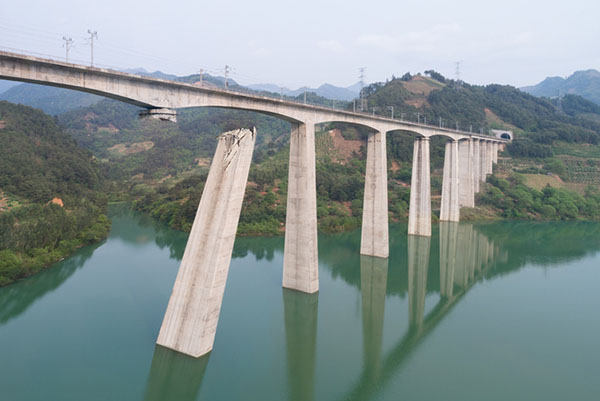Inflation tearing into infrastructure planning, causing some worries
That bridge that was supposed to cost $500 million to repair now is closer to $1 billion. The producer-price index for construction of highways has risen by about one-third from a year earlier. Rolling steel mill products were at one time more than double their costs a year ago before receding some. Plastic construction products are up about 35%, year over year.
And that’s not even counting the price of gasoline and diesel fuel, which increased more than 50% before coming down recently.
It is somewhat cruelly ironic that the singularly bipartisan accomplishment of the Biden administration, the 2,702-page, trillion-dollar infrastructure bill passed with much fanfare by Congress last year, is cited as a factor in the highest inflation rate in 40 years.
Better infrastructure, in the long term, will enhance the supply side of the economy and help keep inflation low.
But in the short term, the infrastructure improvement package will likely have the exact opposite effect. A recent working paper published by the National Bureau of Economic Research found little sign of stimulus effects.
Instead, economic drag occurs in part because building new infrastructure disrupts the use of existing systems. Instead of stimulating the economy, such disruptions actually slow the economy’s supply side, some experts say.
“While the U.S. desperately needs improvements in roads, bridges and tunnels, the timing couldn’t be worse for inflation,” Stephen Miran, who served as a senior adviser for economic policy at the U.S. Treasury in 2020-21, and is a co-founder of Amberwave Partners, wrote in a prescient Wall Street Journal op-ed last year.
Some veteran freight transportation officials agree. The bottom line is inflation already is affecting long-term transport planning.
“I always worry that money will not be spent as it’s meant to be spent,” Randy Mullett, a veteran transportation consultant, told LM. “But unless they’re forced to change decisions regarding formula money for states, I don’t see inflation as being a major hurdle. This was a multi-year bill. Theoretically, inflation could come back down so it won’t have as much impact.”
This is also the first highway bill with money to remove transportation in name of racial equity. Multi-lane highways in Syracuse, New Orleans and other cities are slated for removal.
“We usually have the notion we are using this to build stuff, but this is a little different,” Mullett said. “It’s a big bill with lots of moving parts. I’m not that concerned.”
Already it’s apparent that only about $470 billion of the bill is actual infrastructure. The rest is a variety of money for states to more or less do what they want, as long as it falls along some general guidelines, such as clean water improvements.
Jim Tymon, executive director of the American Association of State Highway and Transportation Officials, has said as the cost of materials for projects rises, “there are going to be fewer projects that you’re able to do.”
So what’s ahead?
Already, state and local officials are under pressure to identify and implement ways to contain costs. These include:
- Allowing more non-union workers on projects;
- Have reasonable environmental requirements; and
- Make funding consistent to avoid the ups/downs in employment and material needs
Some conservatives would favor scrapping the “green” portions of the bipartisan infrastructure law to save money. They say funds designated for “green” projects should be diverted to more immediately needed projects, such as older bridges, roads, buildings etc. to account for inflation. They also believe “green” spending will bankrupt the US with energy instability.
The accounting/consulting firm Deloitte is predicting four possible scenarios about the future of inflation. They are dubbed “Blue Skies,” “Sun Showers,” “Stormy Weather” and “Downdraft.”
In the “Blue Skies” scenario, inflation will revert to recent norms of around 2%. This requires a limited responses from the Federal Reserve and allows consumers to resume spending more on services and less on goods.
The “Sun Showers” scenario posits inflation will decline from current rates but remain elevated between 3-and-4%.
The “Stormy Weather” scenario seems to be what we’re currently in, with inflation rising between 8-and-9%. This could force the Federal Reserve to continue to tighten monetary policy. The result is a recession by 2023 as businesses and consumers pull back on spending plans. The impact of inflation on businesses could subside by 2023, but will remain high for some time.
The “Downdraft” scenario predicts inflation will fall surprisingly below historical norms, potentially below 1%. This could leave factories with excess capacity and inventories, which would have to be sold at a discount.
In any event, Deloitte advises, be prepared for changing conditions. It is recommending businesses shore up their capital structure. They can do that by rebalancing portfolios and lock in today’s cost of capital in anticipation of interest rate increases.
Further, it is advising businesses to:
- Proactively address supply chain disruption;
- Focus on building a diversified supply chain with enough slack to ride out uncertainty;
- Build for continuity. Invest in systems that enable smooth operations in periods of high labor turnover; and
- Consider smart hedges. Make strategic decisions about where to hedge (e.g., pre-buying raw materials) and consider areas most susceptible to destabilization
Bottom line is inflation is undermining the effectiveness of the infrastructure legislation and the government’s monetary policy. Whether the current inflationary period is a short-term blip or something that affects Americans’ ability to collect savings is open to debate. But clearly, $1 trillion isn’t what it used to be.













